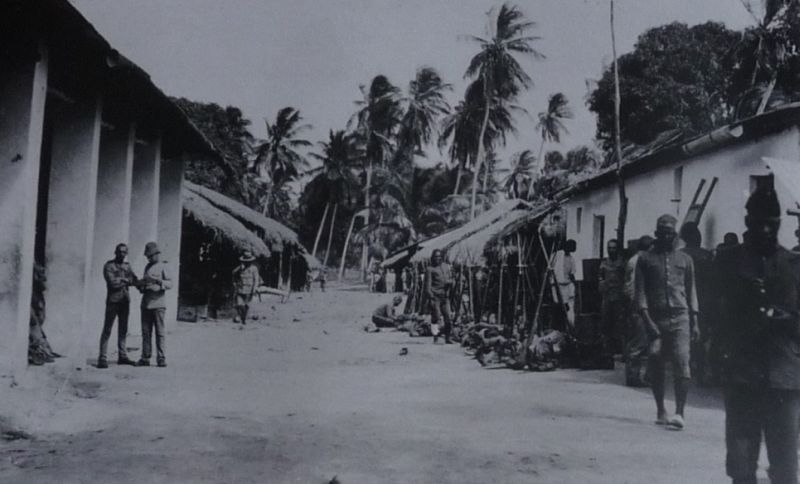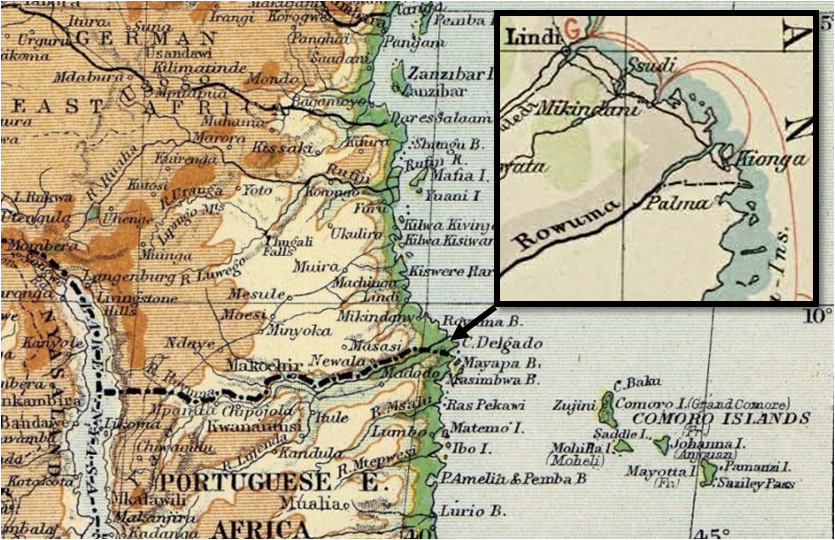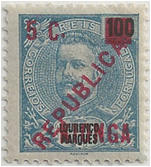ALBUM – View my Portuguese Occupation of the Kionga Triangle album
TRANSITION CHART – Mozambique Area
Fast Facts
Region: Southern Africa
Group: Mozambique Area
Classification: Military Occupation, Portugal
Prior Regime: German East Africa
Key Dates:
1887 – Portugal occupies the Kionga Triangle
1892 – Germans retake the Kionga Triangle Area
1892, May 20 – Kionga Triangle split between Germany and Portugal
1916, Apr 10 – Portuguese troops seize the northern area of the Kionga Triangle from the Germans
1919, May 6 – The Allied Supreme Council assigned the Kionga Triangle as a mandate to Portugal.
Following Regime: Mozambique Colony
Scott Catalogue: (Kionga) #1-4
Pick Catalogue: none
Currency: 1000 reis = 1 milreis, beginning 1912 100 centavos = 1 escudo
History

In an effort to take the land by force, on 18 Feb, 1887 ships from the Portuguese Navy bombarded the German settlements Minangani and Tungi for five days. This was followed by landing parties, which secured the triangle for Portugal up to the Rovuma River. The Germans retaliated, but ultimately the conflict went to arbitration between Germany, Portugal and Great Britain, and the final decision divided the land; allotting the northern portion to the Germans, and the south to the Portuguese. The Portuguese were extremely unhappy with the decision, and considered the outcome an “injustice”.

When WW1 began in Aug 1914, Portugal proclaimed neutrality and did not enter the war. Despite Portugal’s neutral stance, this did not stop the Germans from attacking Portuguese posts both in the colony of Angola on the west coast of Africa, as well as Mozambique Colony on the eastern coast. Eventually, Portugal decided to enter the war on the side of the Allies on 9 Mar, 1916, and four weeks later, on 10 April, they attacked and occupied the German half of the Kionga Triangle.
Although the Portuguese troops suffered from the poor conditions and poor leadership, they continued to push north along the coast of German East Africa. With varied success, skirmishes continued throughout the war.
At the conclusion of World War 1, Portugal was awarded the entire Kionga Triangle in the 1919 Treaty of Versailles and the Kionga Triangle became part of Mozambique Colony.
Stamps
 ALBUM
ALBUM
On May 29, 1916, seven weeks after the occupation, 100-reis postage stamps from the 1898 Lourenço Marques issues were overprinted “KIONGA” and surcharged with four different of the denominations (½c, 1c, 2½c, and 5c) in red. Additionally, the stamps were overprinted “REPUBLICA” in the same fashion as all Portuguese stamps to reflect the overthrow of the monarchy in 1910. All of the overprints were locally applied and it is uncertain of the order that two overprints and the surcharge were applied.
Most of the stock of Lourenço Marques stamps used for these surcharges lacked gum, so Scott states that “unused examples with original gum are worth approximately 50% more in value”.
As there was great interest from collectors in “war stamps” in World War 1, many Kionga stamps were sold to dealers and collectors, however true examples of legitimate covers are rare.
Banknotes
Portuguese Mozambique currency was used in Kionga during the occupation
Links
Portuguese Offensive Operations in 1916
Excellent Article on Kionga and Kionga stamps from John Kevin Doyle





Ah Kionga!
We are on somewhat parallel paths as I have a Kionga post completed and scheduled to be published in May.
Truly fascinating, a philatelic dead country if there ever was one. 😉
As usual, Michael, a very interesting read.
Jim
The difference between your schedule and mine is that you are very systematic and purposeful in your posts, to the contrary, I focus on a few regions for a while and jump around based on what I am working on in my collection (or recently acquired). At the moment I am working on the regions of Mozambique, Ionian Islands, British Nigeria and Thrace.
I should say how much I enjoyed your “Oil Rivers” post also. Obscure, and therefore interesting. 😉
It is true I am systematic, as I post sequentially by alphabet based on the Scott Classic Specialized catalogue.
But that means I have to scramble at times to obtain reasonable material for a scheduled country.